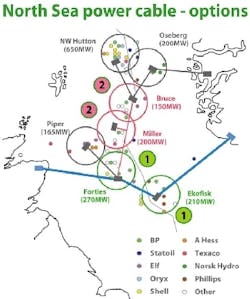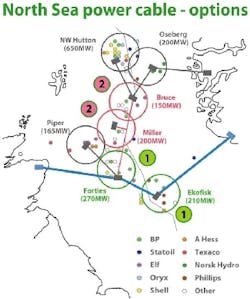NORWAY: Onshore-to-offshore power BP embarking on pioneer scheme
Some 60-70 Norwegian and UK offshore installations in the central and northern North Seas could be powered from shore if an ambitious scheme put forward by BP is implemented. The scheme, the first phase of which could come onstream in the winter of 2003-2004, promises a substantial reduction in greenhouse gas emissions from offshore oil and gas operations in the North Sea, as well as economic and other benefits.
The plan is simple in outline: replace onboard power generation based on diesel or gas turbines with power generated at onshore stations at a much higher level of energy efficiency. Putting it into practice will not be so straightforward. Not only does its technical and economic feasibility have to be shown, but it will require on the part of oil companies and the authorities a willingness to embrace new ways of thinking and cooperating, not only across different licenses but across the median line which has represented a great divide between the UK and Norwegian sectors.
Three goals
Since the scheme was first conceived by BP in early 2000, the many advantages it could bring have become more apparent. BP had three main aims in mind at the start, recounts Olav Fjellsa, manager of industry relations at BP Norge:
- Identifying ways of reducing operating costs on its North Sea fields
- Extending the producing life of its mature fields
- Reducing greenhouse gas emissions.
As the attractions of introducing power from shore became clearer, contractors with expertise in electricity supply systems were invited to join in and provide input. Two have now been shortlisted and are participating in the current phase of work to establish whether the technical option is viable and whether the capital cost estimate of around $ 2 billion is realistic. It is hoped to complete this stage by the end of May and move ahead into detailed design phase.
Other licenses
In parallel, talks have been proceeding with other relevant licenses. If the proposal is to be implemented, it will require the participation of a series of operators, including Amerada Hess, Kerr-McGee, Norsk Hydro, Phillips, Shell, Statoil, Texaco and TotalFinaElf, as well as their partners in the relevant licenses. Even if all these companies perceive benefits in switching to an imported power supply, a daunting work of organization to implement the plan will be involved. The minimum level of participation to make the scheme viable has not yet been established, Fjellsa says.
Importing power represents a break with North Sea tradition. The plan has been met with skepticism in some quarters, according to Fjellsa, on the grounds that to date only one development plan in the two sectors has recommended power transmitted from shore as the preferred solution: this was the plan for the Troll gas development, for which the Troll A gas platform lies only some 65 km from shore.
On the other hand, no one has previously proposed setting up an offshore distribution network to bring power from shore to a large number of installations. In such a scheme, economies of scale obviously play a large role. The economics of the scheme have also been improved by major reductions in transformer and transmitter costs in recent years, Fjellsa says.
Many companies have reacted positively to the prospective benefits of the scheme. From an environmental viewpoint, it is estimated that it could lead to a reduction of seven million tons annually in carbon dioxide emissions from North Sea installations - four million tons in the UK sector and three million tons in the Norwegian sector.
For Norway, that would be equivalent to almost one third of current carbon dioxide emissions from the continental shelf, and a significant contribution to meeting the tough targets which Norway is committed to reach by 2010 under the Kyoto protocol. A significant reduction in nitrogen oxide emissions would also be achieved.
Coming emission standards
As it happens, the offshore industry in northwest Europe is likely to have to meet more stringent emissions targets before then, in the light of moves under way within the European Union to toughen requirements. If this happens, licensees in both Norway and the UK face the prospect of having to make substantial investments to improve the efficiency of on-board power generation facilities anyway.
The removal of on-board power generation would also bring health benefits in eliminating a significant source of noise and safety benefits in that gas would no longer be burned on board. Removing the generating equipment would also free space for other equipment, for example, for enhanced oil recovery, Fjellsa says.
Although for many installations, power would no longer be based on "free" gas from the field, operating costs would be reduced by the smaller number of staff required to maintain the new power distribution system.
This, in turn, could mean an extension of the field's production life, greater recovery and deferred decommissioning costs, Fjellsa says. In Norway, there would be the additional benefit that licensees would be freed from paying the tax on carbon dioxide emissions.
The authorities in both countries have also reacted positively to the plan, according to Fjellsa. In Oslo, its contribution to meeting the Kyoto targets is appreciated, and while this issue is less acute in the UK, the other potential benefits are also acknowledged. The energy ministers of both countries have declared their commitment to working together to ensure the future of North Sea oil and gas production, and this scheme could provide an early opportunity to put that determination into practice.

